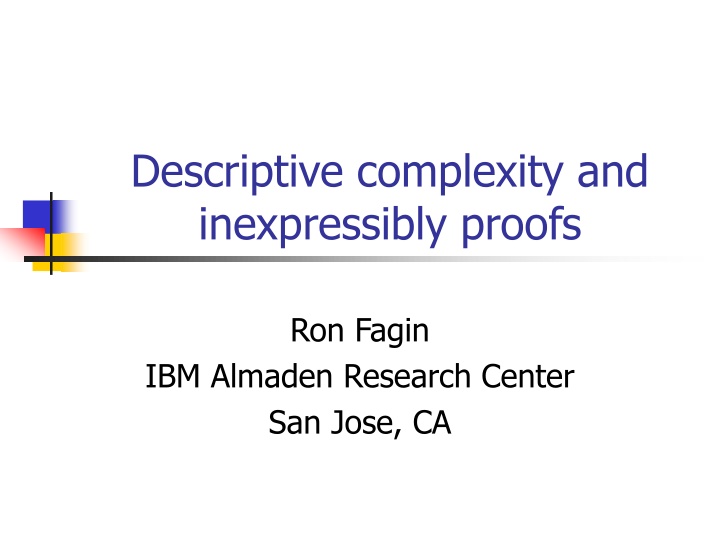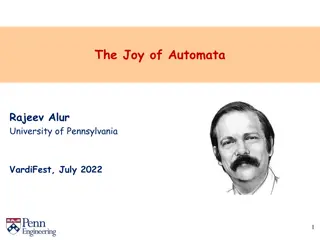
Descriptive Complexity in Complexity Theory
Explore descriptive complexity and inexpressibly proofs in complexity theory, focusing on the connection between computational and descriptive complexity. Discover the intricacies of first-order logic, fixpoint logic, and second-order logic in capturing properties and formulating complex formulas. Delve into the intimate relationship between computational complexity and descriptive complexity in finite model theory.
Download Presentation

Please find below an Image/Link to download the presentation.
The content on the website is provided AS IS for your information and personal use only. It may not be sold, licensed, or shared on other websites without obtaining consent from the author. If you encounter any issues during the download, it is possible that the publisher has removed the file from their server.
You are allowed to download the files provided on this website for personal or commercial use, subject to the condition that they are used lawfully. All files are the property of their respective owners.
The content on the website is provided AS IS for your information and personal use only. It may not be sold, licensed, or shared on other websites without obtaining consent from the author.
E N D
Presentation Transcript
Descriptive complexity and inexpressibly proofs Ron Fagin IBM Almaden Research Center San Jose, CA
Complexity Theory Traditional focus: computational complexity Amount of resources such as time or space, required by a machine that solves the problem More recent branch of complexity theory (and finite model theory): descriptive complexity Complexity of describing properties in some logical formalism
Descriptive Complexity Examples Which logic can capture a given property? First-order logic Fixpoint logic Second-order logic In a given logic (say, first-order logic), how complex a formula is required to capture the property? Quantifier depth? How many quantifiers? How many variables?
Descriptive Complexity (contd.) There is an intimate connection between computational complexity and descriptive complexity in finite model theory
First-order logic vs. existential second-order logic Typical sentence in first-order logic (can quantify over points): ? ? (?(?,?) ?(?,?)) In existential second-order logic, or 1 relations 1, we can existentially quantify over sets or
1example: 3-colorability 1 Edge relation P Colors Q1,Q2,Q3 ? P,Q1,Q2,Q3 is a first-order sentence saying Each point has exactly one color, and no edge has two points with the same color Q1 Q2 Q3? says the graph is 3- colorable
1Class 1 1sentence: Q1 Qk?, where ? is 1 first-order, and each Qiis a set or relation 1 a 1 We are considering here only finite models, such as finite graphs 1class: class of, say, graphs, defined by 1sentence
Theorem (Fagin 1974): 1 1= NP Conclusion: If we can separate 1 complement 1 NP from co-NP 1from its 1, then we have separated
Our motivation This motivates developing techniques for proving inexpressibility results (and hence separation results) in finite model theory
Tools to Prove Inexpressibility Results in Logic Finite case: Compactness Theorem L wenheim-Skolem Theorem Ehrenfeucht-Fra ss games
Purpose of This Talk Discuss results and techniques that assist in the use of Ehrenfeucht-Fra ss games to make easier the task of proving inexpressibility results
1st-Order Ehrenfeucht-Frass Game r-game between Spoiler and Duplicator 3 1 2 2 1 3
1st-Order Ehrenfeucht-Frass Game r-game between Spoiler and Duplicator 3 1 2 2 1 3 If Duplicator has winning strategy, write ?0 ~??1
Importance of Ehrenfeucht- Fra ss Games Theorem (Ehrenfeucht 1961, Fraisse 1954): S is expressible in first-order logic if and only if there is ? such that whenever G0 S and G1 Sc, then Spoiler has a winning strategy in the ?- game over G0,G1
Importance of Ehrenfeucht- Fra ss Games (contd.)
Hanfs Technique d-type of a point a: isomorphism type of (open) neighborhood of radius d about a G0 and G1 are d-equivalent if for every d-type , both G0 and G1 have the same number of points of d-type d = 3 3 2 1 1 1 1
Hanfs Theorem Theorem (essentially Hanf 1965): Let r be a positive integer. There is a positive integer d such that whenever G0 and G1 are d-equivalent, then G0 ~r G1 d-equivalence is a type of local isomorphism Can weaken assumption of d-equivalence to say that for every d-type , either G0 and G1 have the same number of points of d-type , or both have many points with d-type Example: one sufficiently big cycle versus two sufficiently big cycles
Capturing Monadic NP by games (c,r)-game over G0,G1 1. Spoiler colors G0 with the c colors 2. Duplicator colors G1 with the c colors 3. Spoiler and Duplicator play the r-game over colored G0,G1
Theorem (Fagin, 1975) : S is in monadic NP if and only if there are c,r such that whenever G0 S and G1 Sc, then Spoiler has a winning strategy in the (c,r)-game over G0,G1. Basic idea: if S defined by Q1 Qk?, let c = 2?
Theorem (Fagin 1975): Connectivity is not in monadic NP Original proof:
Showed that given c, r, there are cycles C0, C1 such that if G0 = C0 and G1 = C0 + C1, then Duplicator can win the (c, r)-game over G0, G1 c0 c0 c1
Duplicator's coloring strategy: color C0 in G1by mimicking the coloring of C0 in G0, and color C1 in a way where every d-type in C1 appears many times in C0 c0 c0 c1
Duplicator's coloring strategy: color C0 by mimicking the coloring of G0, and color C1 in a way where every d-type in C1 appears many times in C0 c0 c0 c1
Duplicator's coloring strategy: color C0 by mimicking the coloring of G0, and color C1 in a way where every d-type in C1 appears many times in C0 c0 c0 c1
Duplicators pebbling strategy: given explicitly Note: for pebbling strategy, could have used the extended Hanf condition c0 c0 c1
Difficulties in Original Proof Selection of graphs Duplicator s coloring strategy Duplicator s pebbling strategy
Changing Rules of the Game (c, r)-game over class S of graphs: Duplicator selects member of S to be G0 Duplicator selects member of Sc to be G1 Spoiler colors G0 with the c colors Duplicator colors G1 with the c colors Spoiler and Duplicator play r-game on colored G0 and G1 1. 2. 3. 4. 5.
Ajtai-Fagin Game Ajtai-Fagin (c, r)-game over class S of graphs: Duplicator selects member of S to be G0 2. Spoiler colors G0 with the c colors 3. Duplicator selects member of Sc to be G1 4. Duplicator colors G1 with the c colors 5. Spoiler and Duplicator play r-game on colored G0 and G1 1. This game still characterizes monadic NP Theorem (Ajtai and Fagin 1990): S is in monadic NP if and only if there are c, r such that Spoiler has a winning strategy in the Ajtai-Fagin (c, r)-game over S
Ajtai-Fagin Game (contd.) Ajtai and I used Ajtai-Fagin games to prove that directed s-t connectivity is not in monadic NP We did not see how to use Fagin games to prove that directed s-t connectivity is not in monadic NP Remark: undirected s-t connectivity is in monadic NP
Ajtai-Fagin Game (contd.) The Ajtai-Fagin game is easier for Duplicator to win This makes our inexpressibility proofs easier In fact, can prove (Fagin 1995) that in a precise sense, the game is easier for Duplicator to win (Spoiler requires more colors to win)
Moshe suggestion to Ron Let s try to use Ajtai-Fagin games to get an easier proof that connectivity is not in monadic NP
Simpler Proof Using Our Tools Theorem: Connectivity is not in monadic NP Proof (Fagin, Stockmeyer, and Vardi 1995): If in monadic NP, take c, r such that Spoiler wins Ajtai-Fagin (c, r)-game over the class of connected graphs. Find d as in Hanf s Theorem Let G0be big directed cycle; let Spoiler color G0
Since G0 is big, there are two points a and b at least 2d apart with the same d-type a G0 b
Duplicator selects and colors G1 a G0 b a G1 b Duplicator can now win, by Hanf s Theorem!
How Proof has been Simplified Selection of graphs Simply pick G0 to be large enough cycle Duplicator s coloring strategy Simply mimic Spoiler s coloring Duplicator s pebbling strategy Appeal to Hanf
Corollary Corollary: Monadic NP is not closed under complement Proof: Non-connectivity is in monadic NP, via There is a set S where S and its complement are nonempty, and there is no edge from a member of S to a member of its complement

